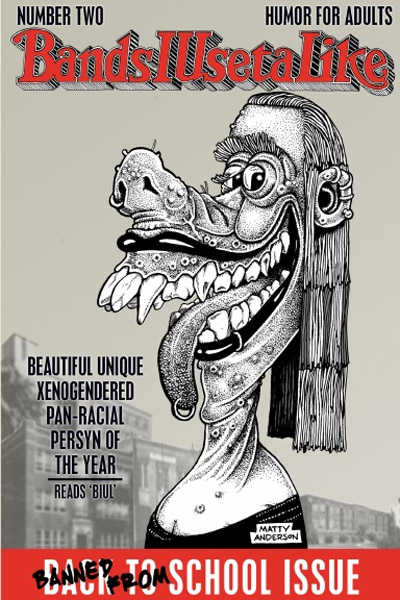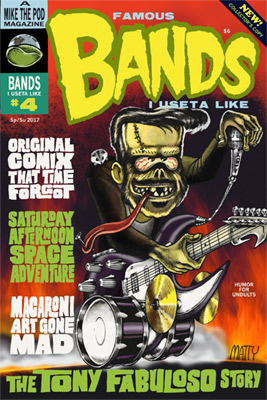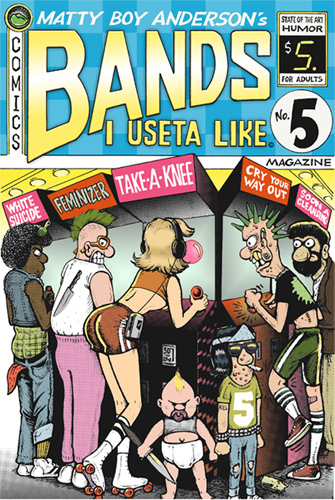When retiring his comic strip Bloom County, Berke Breathed remarked “a good comic strip is as eternal as a ripe melon.” Personally, I think that’s bullshit, and reflects more on Breathed’s motivation, or lack thereof. A good comic strip lasts a lifetime. We still pass around clippings of The Far Side and Fabulous Furry Freak Brothers, decades after they were printed. A cartoonist who can’t perpetuate over changing times has inked themselves into a corner. Or dried the well.
If a comic strip is still hilarious long past its sell-by date, it is a successful comic strip. That is the acid test.
No Exit was a syndicated comic strip created by Erik Andresen, a student at the University of Arizona. The above image is the cover of a 1991 collection from Tucson’s Bean Avenue Publishing. This dude hit the ground running, with a serious pedigree. From the back of the book:
Erik Andresen’s syndicated cartoon No Exit is enjoyed by thousands of college students and former college students across the United States. Andresen, a finalist in the 1989 Scripps-Howard Charles M. Schulz College Cartoonist Award, began his professional career with the publication of No Exit in the University of Arizona’s Daily Wildcat in 1986. Andresen’s overwhelming success and notority [sic] led to the syndication of No Exit, now seen in more than 130 college and university newspapers. Andresen lives in Tucson, Arizona.
That is nothing to sneeze at, folks.
I mentioned in my article on Jeff Shesol’s Thatch that many cartoonists circa 1990 (myself included) utilized a variation on Breathed’s Bloom County eyes. Those were, in turn, adapted from the peepers in Trudeau’s Doonesbury. Andresen starts off in that mode, then slowly builds his own aesthetic. It’s bumpy in spots, but that’s the way these things develop. However, Andresen kicks off the strip the hard way: no cast of characters.
If you think writing a comic strip is difficult, it’s a hundred times harder when you start with a blank slate every time. You’re not developing the exploits of imaginary individuals, you’re letting the strip sink or swim based on the strength of its humor. This is why there’s only one Far Side, and a million Garfields. With a cast of characters, you can mine their fictional lives for inspiration on Monday morning. With a humor anthology strip, writer’s block can make you ready to lick a noose. So I really have tremendous respect for what Andresen forged here.
One can see from his introduction that Erik was no box of parts. This guy knew what he was doing from the drop. Before I show you the strips as evidence, check out this beautifully diplomatic introduction from the book. This is a ridiculously healthy and wise attitude for a young cartoonist to have towards their craft, and the world.
Cartooning is a medium of ideas, both in its art and its writing. A cartoonist, for example, does not draw a face or a hand so much as the idea of a face or a hand. Similarly, when I draw Dan Quayle, I am really drawing only an idea of Dan Quayle, wholly separate from the actual person Dan Quayle.
No Exit is a hodge-podge of ideas, which may or may not have anything to do with my personal opinions. My own political or social bent would be too coldly rational to make for interesting cartoon fare. After all, like you the reader, I am only one person. Who am I to dictate morality to my cartoon characters?
Thus, when you see a cartoon which may be too liberal or too conservative for your tastes, consider that it may be too extreme for my tastes as well. But also consider that it is only an idea. If you are offended by an idea, please stop for a moment and think why you are so affected. If you can logically refute an idea with your convictions, then that makes your convictions that much stronger. However, if your opinions cannot stand the scrutiny of an idea, perhaps they should be modified to accomodate [sic] it. (You may also be misreading the cartoon, but that’s another matter.)
At any rate, I hope you enjoy No Exit.
Your friendly cartoonist,
Erik Andresen
Yes, there are many Dan Quayle gags; at the time, he was George H.W. Bush’s vice president. He famously misspelled “potato”. All those people on social media going berserk over “covfefe”- same shit, different year. There is nothing new under the sun, okay? That’s why fewer and fewer people care about whatever the hell “covfefe” was supposed to mean. Like the endless jokes about Prince Charles and Lady Di in Bloom County, they are as eternal as a ripe melon.
The difference is, Andresen turned out strips like the following, as seen on the back cover.
Savor the brevity of that George Will line. It elevates every other joke in the strip. It’s so good, I’ve ripped it off in casual conversation for over twenty years, to sound witty. Sometimes I substitute Amber Heard, or John Heard, if I don’t feel like bringing that gold-digger up. Edward Burns, there’s another one. Ahh, les mot juste!
Andresen’s cultural eye was so keen, some of his predictions were just about accurate.
The New Kids on the Block shortened their name to NKOTB a year later, in 1993. Their 2008 album was titled The Block. Andresen wrote this in 1990. That’s pretty goddamn sharp, folks.
You like memes, don’t you? Of course, that’s how you learn about the world around you, and naturalize your prejudices. Guess what- Andresen prefigured that too. Look at the following strip. You could replace Quayle with Donald Trump, and get a hundred likes on Facebook. Thanks to the loose drawing style, you wouldn’t even have to alter the hair.
Am I wrong? See what a solid strip we have here?
(Yes, Andresen uses the European “7” with the dash through it. I hope that doesn’t bug you.)
Guns have been in the news again lately, because guns are always in the news. That means inevitably, the NRA gets some sunlight too. You might be too young to realize that the NRA is a common target in comics. Literally any shot you can take at the NRA’s expense has been previously fired. Most are nowhere near as precise as the following:
7 lines, pretty much every one a homer. That John Lennon joke is brilliant. The whole thing is prescient as fuck. And it’s from 1990.
As the saying goes, death and taxes are inevitable. If you can write a good comic strip about either, you’re evergreen.
Panels two and three are a scream. Personally, I get an extra laugh from the first panel. Since around 2010, I’ve been getting by on under $7,000 a year. I’m technically not supposed to be alive. That’s life for a freelance cartoonist in the 21st century, folks. That’s why all the comics you see now are corporate-owned, terrible, or both. I do what I can to fix that, do you? If you’re so smart, why don’t you figure it out yourself, you stupid, incompetent jerk?
So many strips in the collection are great, I can’t even give you a decent cross-section here. I’m leaving out the heavily college/fraternity-oriented ones, merely because they reference that life specifically (in Arizona), not because they’re less funny (they’re not). Have a gander at this one, and note how many gags on Family Guy and Robot Chicken it foretold:
 I don’t know, would toxic waste injure Oscar the Grouch? Eh, maybe. That first panel more or less predicted Common Core, though.
I don’t know, would toxic waste injure Oscar the Grouch? Eh, maybe. That first panel more or less predicted Common Core, though.
I’m gonna wrap this up with two more. Narrowing down the choices was much harder than I expected. Just about every strip in the book is good for a laugh, and they’re all clean. That’s as much of a challenge for a cartoonist as a strip with no recurring characters.
Note your reaction to the magnificent punch panel below.
That’s a beauty, ain’t it?
For the closer, here’s Andresen’s take on political correctness, that perennial adversary of free speech. Concise, astute, enduringly prescient, hilarious. You can see Andresen’s style beginning to emerge in this early submission, plus there’s references to Kafka and Snausages. Snausages.



















You must be logged in to post a comment.